DODGE DURANGO 2022 Vehicle Warranty
Manufacturer: DODGE, Model Year: 2022, Model line: DURANGO, Model: DODGE DURANGO 2022Pages: 200, PDF Size: 6.72 MB
Page 171 of 200
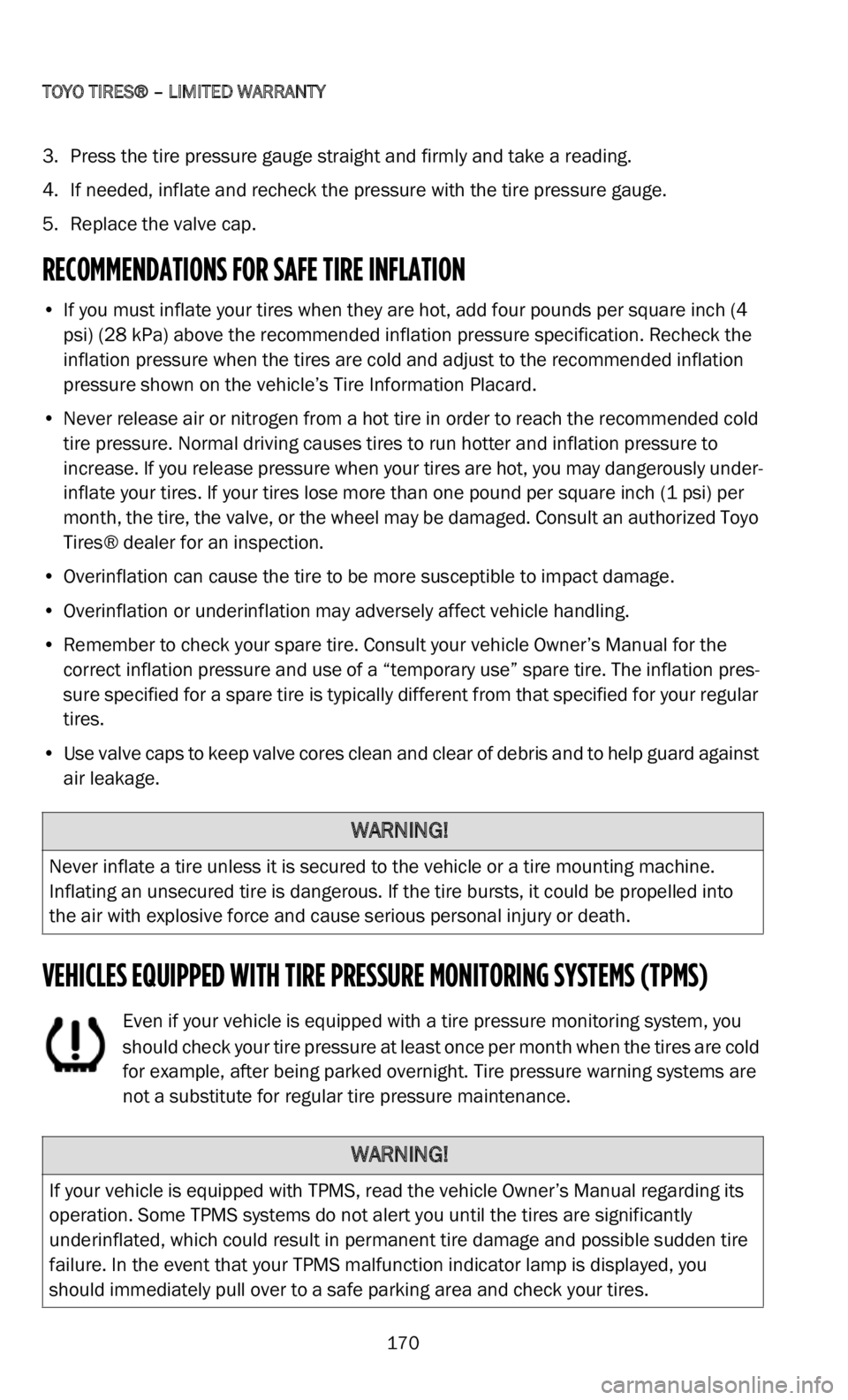
TOYO TIRES® – LIMITED WARRANTY
170
3. Press the tire pressure gauge straight and firmly and take a reading.
4. If needed, inflate and recheck the pressure with the tire pressure gauge.
5
. R eplace the valve cap.
RECOMMENDATIONS FOR SAFE TIRE INFLATION
• If you must inflate your tires when they are hot, add four pounds per square inch (4
psi) (28 kPa) above the recommended inflation pressure specification. Recheck the
inflation pressure when the tires are cold and adjust to the recommended inflation
pressure shown on the vehicle’s Tire Information Placard.
• N ever release air or nitrogen from a hot tire in order to reach the recommended cold
t
ire pressure. Normal driving causes tires to run hotter and inflation pressure to
increase. If you release pressure when your tires are hot, you may dangerously under -
inflate your tires. If your tires lose more than one pound per square inch (1 psi) per
m o
nth, the tire, the valve, or the wheel may be damaged. Consult an authorized Toyo
Tires® dealer for an inspection.
• O verinflation can cause the tire to be more susceptible to impact damage.
•
Overinflation or underinflation may adversely affect vehicle handling.
•
Remember to check your spare tire. Consult your vehicle Owner’s Manual for the
c
orrect inflation pressure and use of a “temporary use” spare tire. The inflation pres -
sure specified for a spare tire is typically different from that specified for your regular
t i
res.
• U se valve caps to keep valve cores clean and clear of debris and to help guard against
a
ir leakage.
VEHICLES EQUIPPED WITH TIRE PRESSURE MONITORING SYSTEMS (TPMS)
Even if your vehicle is equipped with a tire pressure monitoring system, you
should check your tire pressure at least once per month when the tires are cold
fo
r example, after being parked overnight. Tire pressure warning systems are
not a substitute for regular tire pressure maintenance.
WARNING!
Never inflate a tire unless it is secured to the vehicle or a tire mounting machine.
Inflating an unsecured tire is dangerous. If the tire bursts, it could be propelled into
the air with explosive force and cause serious personal injury or death.
WARNING!
If your vehicle is equipped with TPMS, read the vehicle Owner’s Manual regarding its
operation. Some TPMS systems do not alert you until the tires are significantly
underinflated, which could result in permanent tire damage and possible sudden tire
failure. In the event that your TPMS malfunction indicator lamp is displayed, you
should immediately pull over to a safe parking area and check your tires.
Page 172 of 200
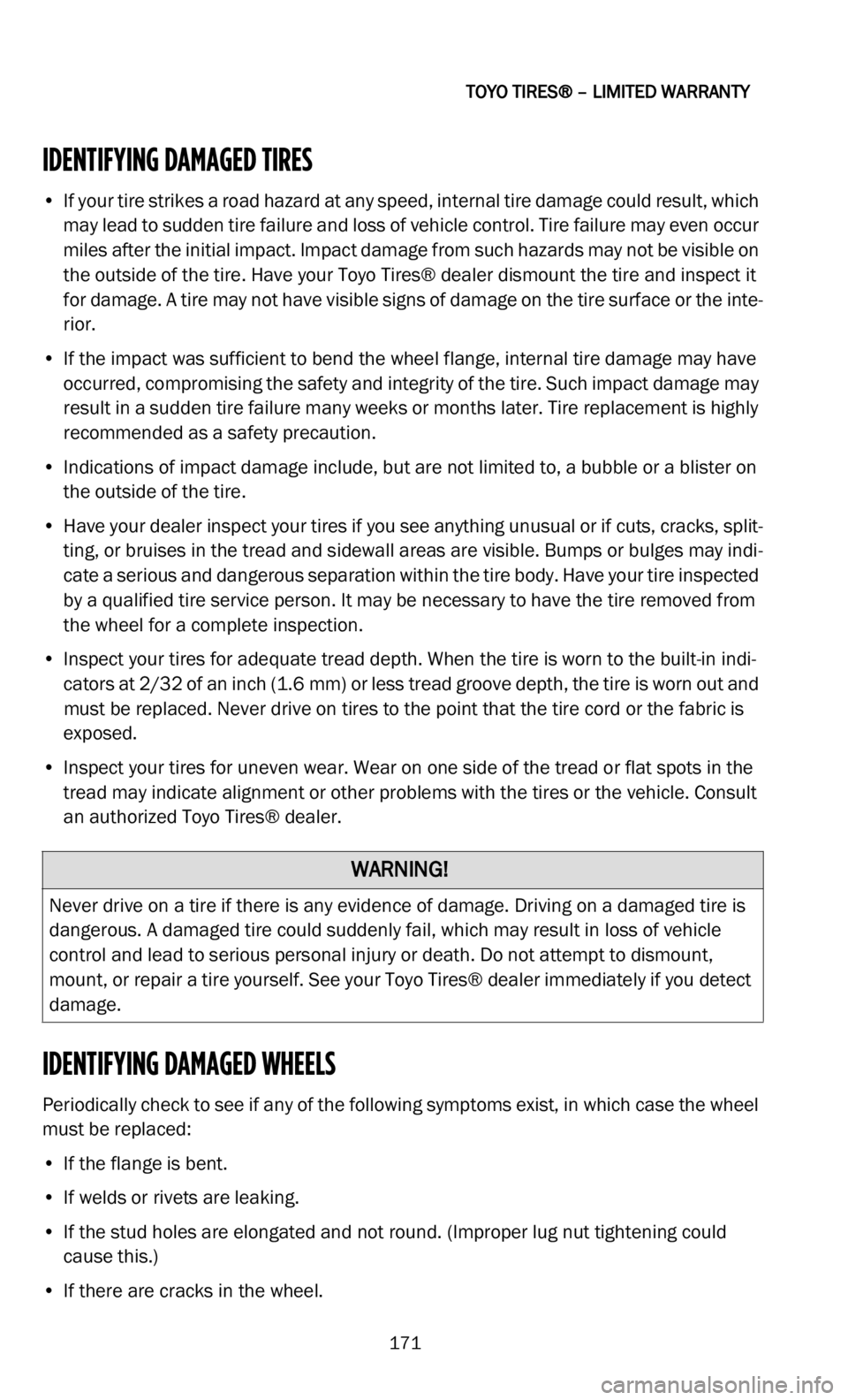
TOYO TIRES® – LIMITED WARRANTY
171
IDENTIFYING DAMAGED TIRES
• If your tire strikes a road hazard at any speed, internal tire damage could result, which may lead to sudden tire failure and loss of vehicle control. Tire failure may even occur
miles after the initial impact. Impact damage from such hazards may not be visible on
the outside of the tire. Have your Toyo Tires® dealer dismount the tire and inspect it
for damage. A tire may not have visible signs of damage on the tire surface or the inte -
rior.
• I f the impact was sufficient to bend the wheel flange, internal tire damage may have
o
ccurred, compromising the safety and integrity of the tire. Such impact damage may
result in a sudden tire failure many weeks or months later. Tire replacement is highly
recommended as a safety precaution.
• I ndications of impact damage include, but are not limited to, a bubble or a blister on
t
he outside of the tire.
• H ave your dealer inspect your tires if you see anything unusual or if cuts, cracks, split -
t
ing, or bruises in the tread and sidewall areas are visible. Bumps or bulges may indi -
cate a serious and dangerous separation within the tire body. Have your tire inspected
b y
a qualified tire service person. It may be necessary to have the tire removed from
the wheel for a complete inspection.
• I nspect your tires for adequate tread depth. When the tire is worn to the built-in indi -
c
ators at 2/32 of an inch (1.6 mm) or less tread groove depth, the tire is worn out and
m u
st be replaced. Never drive on tires to the point that the tire cord or the fabric is
exposed.
• I nspect your tires for uneven wear. Wear on one side of the tread or flat spots in the
t
read may indicate alignment or other problems with the tires or the vehicle. Consult
an authorized Toyo Tires® dealer.
IDENTIFYING DAMAGED WHEELS
Periodically check to see if any of the following symptoms exist, in which case the wheel
must be replaced:
• I f the flange is bent.
•
If welds or rivets are leaking.
•
If the stud holes are elongated and not round. (Improper lug nut tightening could
c
ause this.)
• I f there are cracks in the wheel.
WARNING!
Never drive on a tire if there is any evidence of damage. Driving on a damaged tire is
dangerous. A damaged tire could suddenly fail, which may result in loss of vehicle
control and lead to serious personal injury or death. Do not attempt to dismount,
mount, or repair a tire yourself. See your Toyo Tires® dealer immediately if you detect
damage.
Page 173 of 200
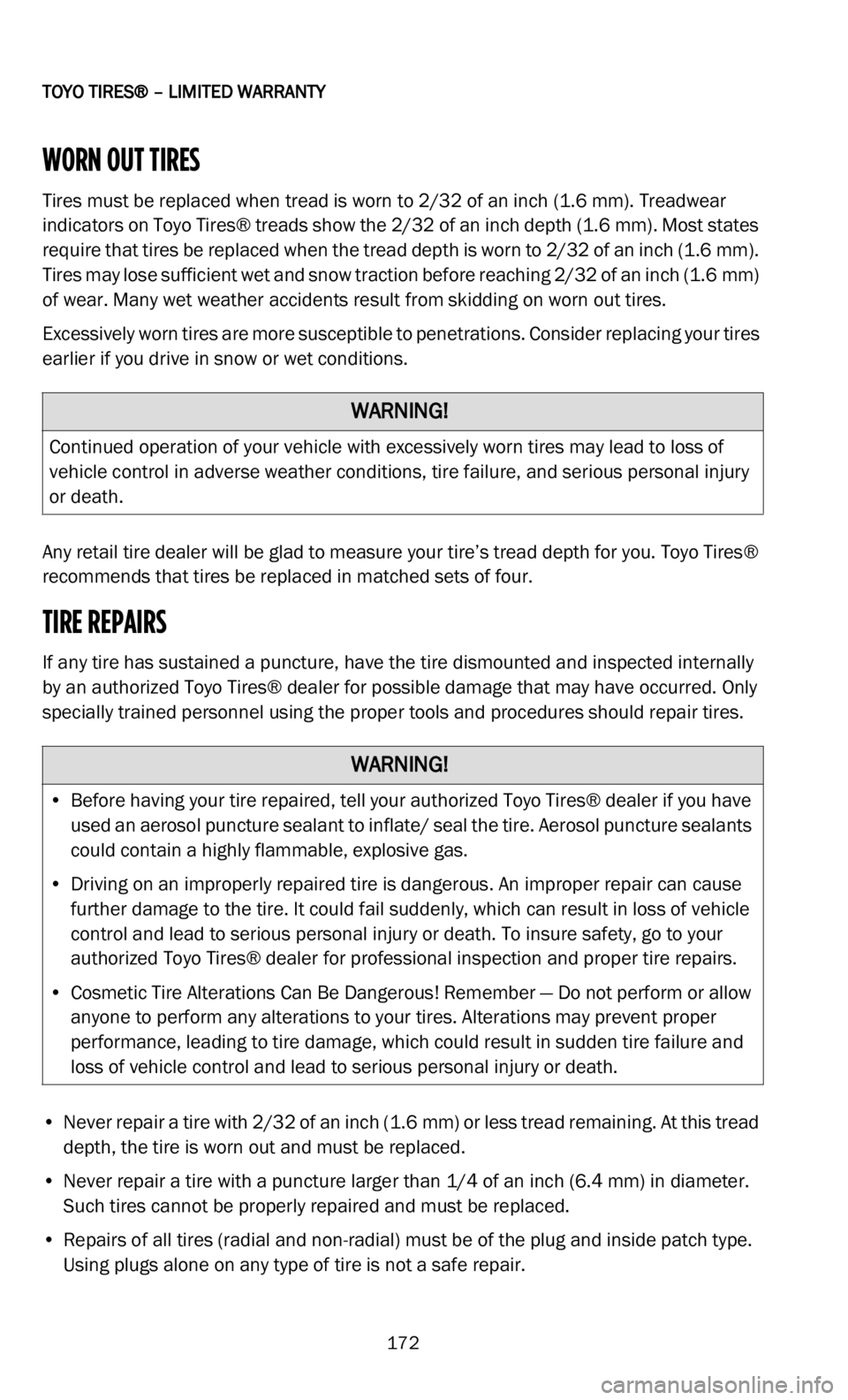
TOYO TIRES® – LIMITED WARRANTY
172
WORN OUT TIRES
Tires must be replaced when tread is worn to 2/32 of an inch (1.6 mm). Treadwear
in
dicators on Toyo Tires® treads show the 2/32 of an inch depth (1.6 mm). Most states
r e
quire that tires be replaced when the tread depth is worn to 2/32 of an inch (1.6 mm).
T i
res may lose sufficient wet and snow traction before reaching 2/32 of an inch (1.6 mm)
o f
wear. Many wet weather accidents result from skidding on worn out tires.
Excessively worn tires are more susceptible to penetrations. Consider replacing your tires
e a
rlier if you drive in snow or wet conditions.
Any retail tire dealer will be glad to measure your tire’s tread depth for you. Toyo Tires®
r e
commends that tires be replaced in matched sets of four.
TIRE REPAIRS
If any tire has sustained a puncture, have the tire dismounted and inspected internally
by an authorized Toyo Tires® dealer for possible damage that may have occurred. Only
specially trained personnel using the proper tools and procedures should repair tires.
• N ever repair a tire with 2/32 of an inch (1.6
mm) or less tread remaining. At this tread
de
pth, the tire is worn out and must be replaced.
• N ever repair a tire with a puncture larger than 1/4 of an inch (6.4
mm) in diameter.
Su
ch tires cannot be properly repaired and must be replaced.
• R epairs of all tires (radial and non-radial) must be of the plug and inside patch type.
U
sing plugs alone on any type of tire is not a safe repair.
WARNING!
Continued operation of your vehicle with excessively worn tires may lead to loss of
vehicle control in adverse weather conditions, tire failure, and serious personal injury
or death.
WARNING!
• Before having your tire repaired, tell your authorized Toyo Tires® dealer if you have used an aerosol puncture sealant to inflate/ seal the tire. Aerosol puncture sealants
could contain a highly flammable, explosive gas.
• D riving on an improperly repaired tire is dangerous. An improper repair can cause
f
urther damage to the tire. It could fail suddenly, which can result in loss of vehicle
control and lead to serious personal injury or death. To insure safety, go to your
authorized Toyo Tires® dealer for professional inspection and proper tire repairs.
• C osmetic Tire Alterations Can Be Dangerous! Remember — Do not perform or allow
a
nyone to perform any alterations to your tires. Alterations may prevent proper
performance, leading to tire damage, which could result in sudden tire failure and
loss of vehicle control and lead to serious personal injury or death.
Page 174 of 200
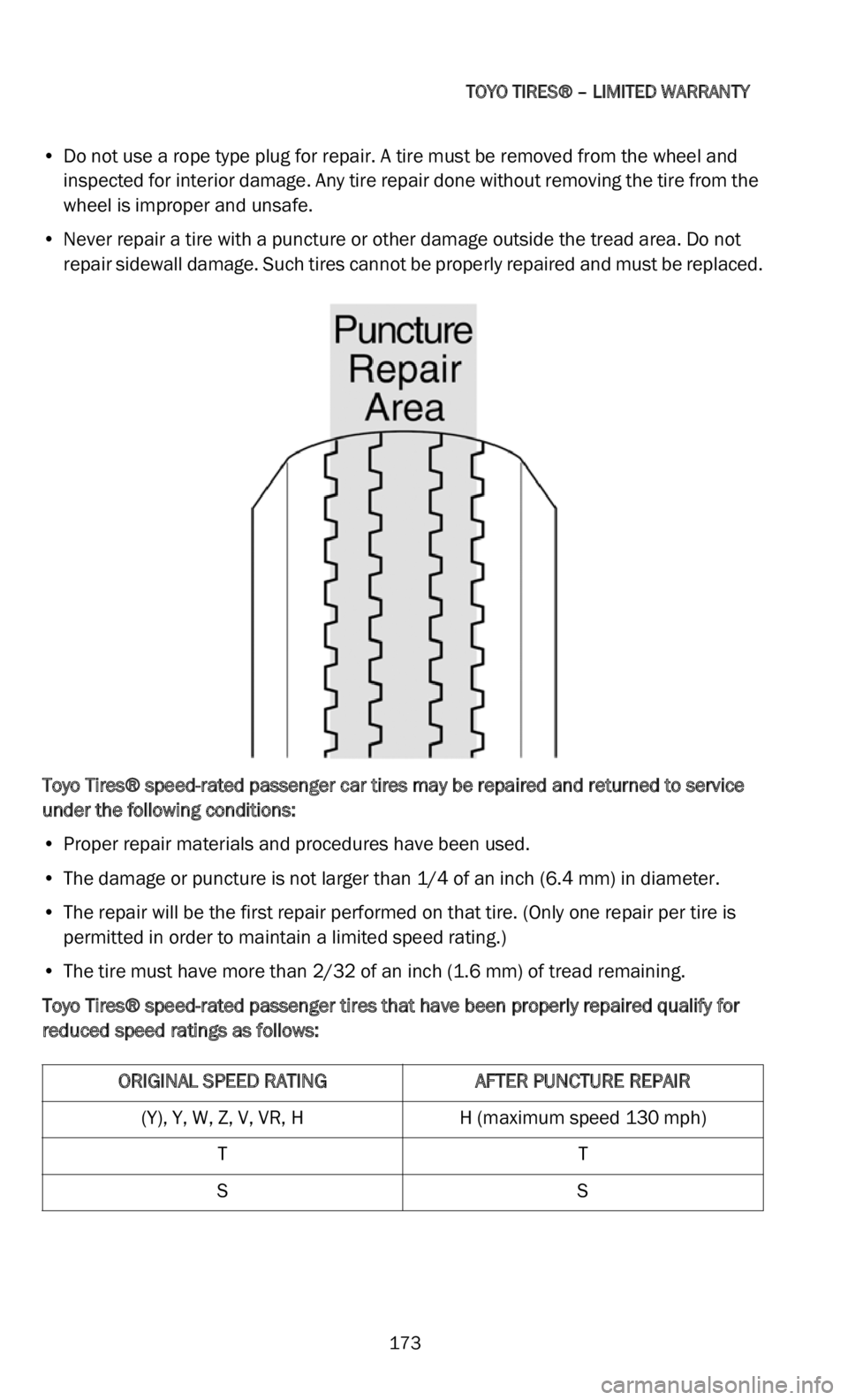
TOYO TIRES® – LIMITED WARRANTY
173
• Do not use a rope type plug for repair. A tire must be removed from the wheel and inspected for interior damage. Any tire repair done without removing the tire from the
wheel is improper and unsafe.
• N ever repair a tire with a puncture or other damage outside the tread area. Do not
r
epair sidewall damage. Such tires cannot be properly repaired and must be replaced.
Toyo Tires® speed-rated passenger car tires may be repaired and returned to service
u n
der the following conditions:
• P roper repair materials and procedures have been used.
•
The damage or puncture is not larger than 1/4 of an inch (6.4
mm) in diameter.
• T he repair will be the first repair performed on that tire. (Only one repair per tire is
p
ermitted in order to maintain a limited speed rating.)
• T he tire must have more than 2/32 of an inch (1.6
mm) of tread remaining.
Toyo Tires® speed-rated passenger tires that have been properly repaired qualify for
r e
duced speed ratings as follows:
ORIGINAL SPEED RATING AFTER PUNCTURE REPAIR
(Y), Y, W, Z, V, VR, H H (maximum speed 130 mph)
T T
S S
Page 175 of 200
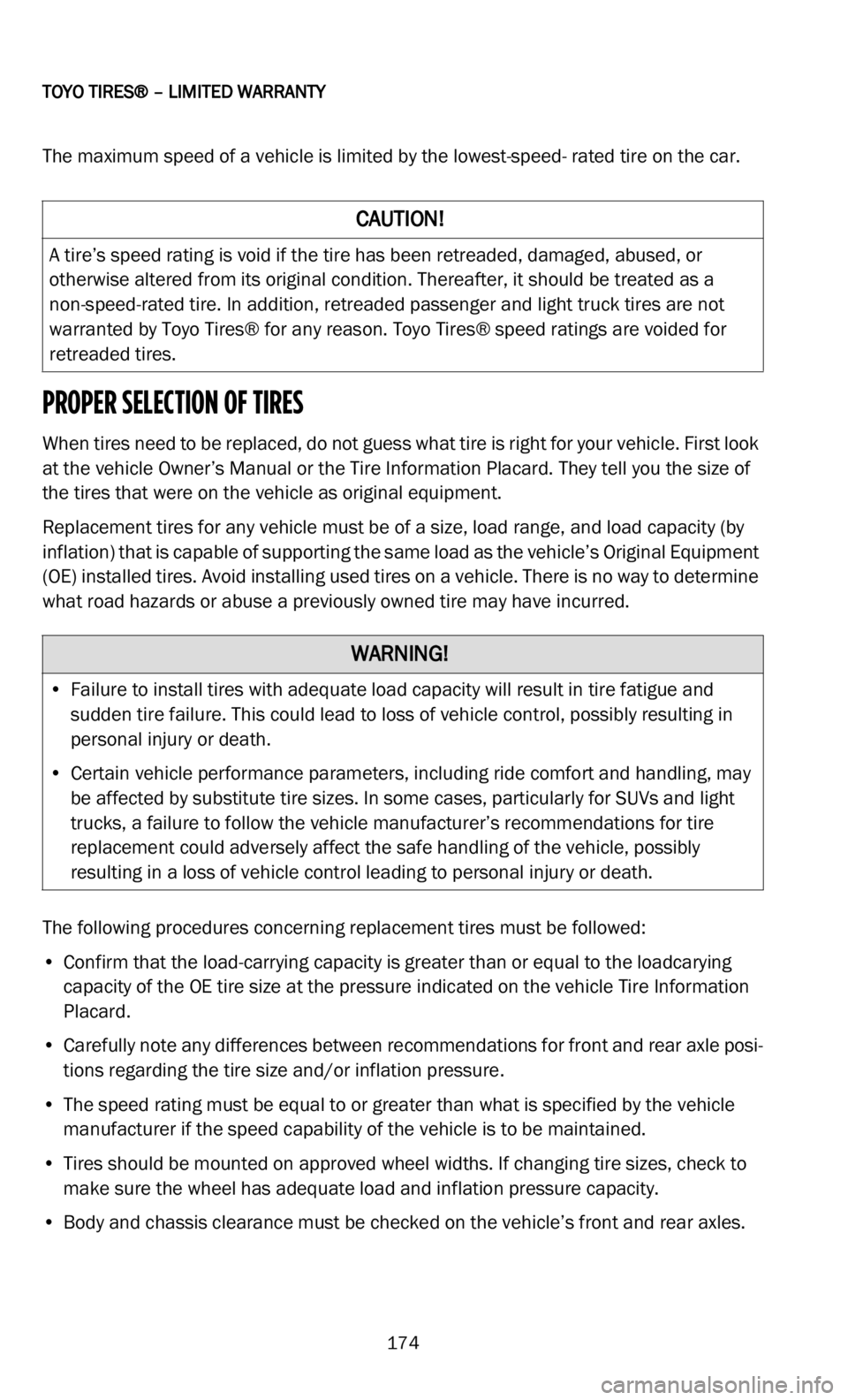
TOYO TIRES® – LIMITED WARRANTY
174
The maximum speed of a vehicle is limited by the lowest-speed- rated tire on the car.
PROPER SELECTION OF TIRES
When tires need to be replaced, do not guess what tire is right for your vehicle. First look
at the vehicle Owner’s Manual or the Tire Information Placard. They tell you the size of
the tires that were on the vehicle as original equipment.
Replacement tires for any vehicle must be of a size, load range, and load capacity (by
in
flation) that is capable of supporting the same load as the vehicle’s Original Equipment
(OE) installed tires. Avoid installing used tires on a vehicle. There is no way to determine
what road hazards or abuse a previously owned tire may have incurred.
The following procedures concerning replacement tires must be followed:
• C onfirm that the load-carrying capacity is greater than or equal to the loadcarying
c
apacity of the OE tire size at the pressure indicated on the vehicle Tire Information
Placard.
• C arefully note any differences between recommendations for front and rear axle posi -
t
ions regarding the tire size and/or inflation pressure.
• T he speed rating must be equal to or greater than what is specified by the vehicle
m
anufacturer if the speed capability of the vehicle is to be maintained.
• T ires should be mounted on approved wheel widths. If changing tire sizes, check to
m
ake sure the wheel has adequate load and inflation pressure capacity.
• B ody and chassis clearance must be checked on the vehicle’s front and rear axles.
CAUTION!
A tire’s speed rating is void if the tire has been retreaded, damaged, abused, or
otherwise altered from its original condition. Thereafter, it should be treated as a
non-speed-rated tire. In addition, retreaded passenger and light truck tires are not
warranted by Toyo Tires® for any reason. Toyo Tires® speed ratings are voided for
retreaded tires.
WARNING!
• Failure to install tires with adequate load capacity will result in tire fatigue and
sudden tire failure. This could lead to loss of vehicle control, possibly resulting in
personal injury or death.
• C ertain vehicle performance parameters, including ride comfort and handling, may
b
e affected by substitute tire sizes. In some cases, particularly for SUVs and light
trucks, a failure to follow the vehicle manufacturer’s recommendations for tire
replacement could adversely affect the safe handling of the vehicle, possibly
resulting in a loss of vehicle control leading to personal injury or death.
Page 176 of 200
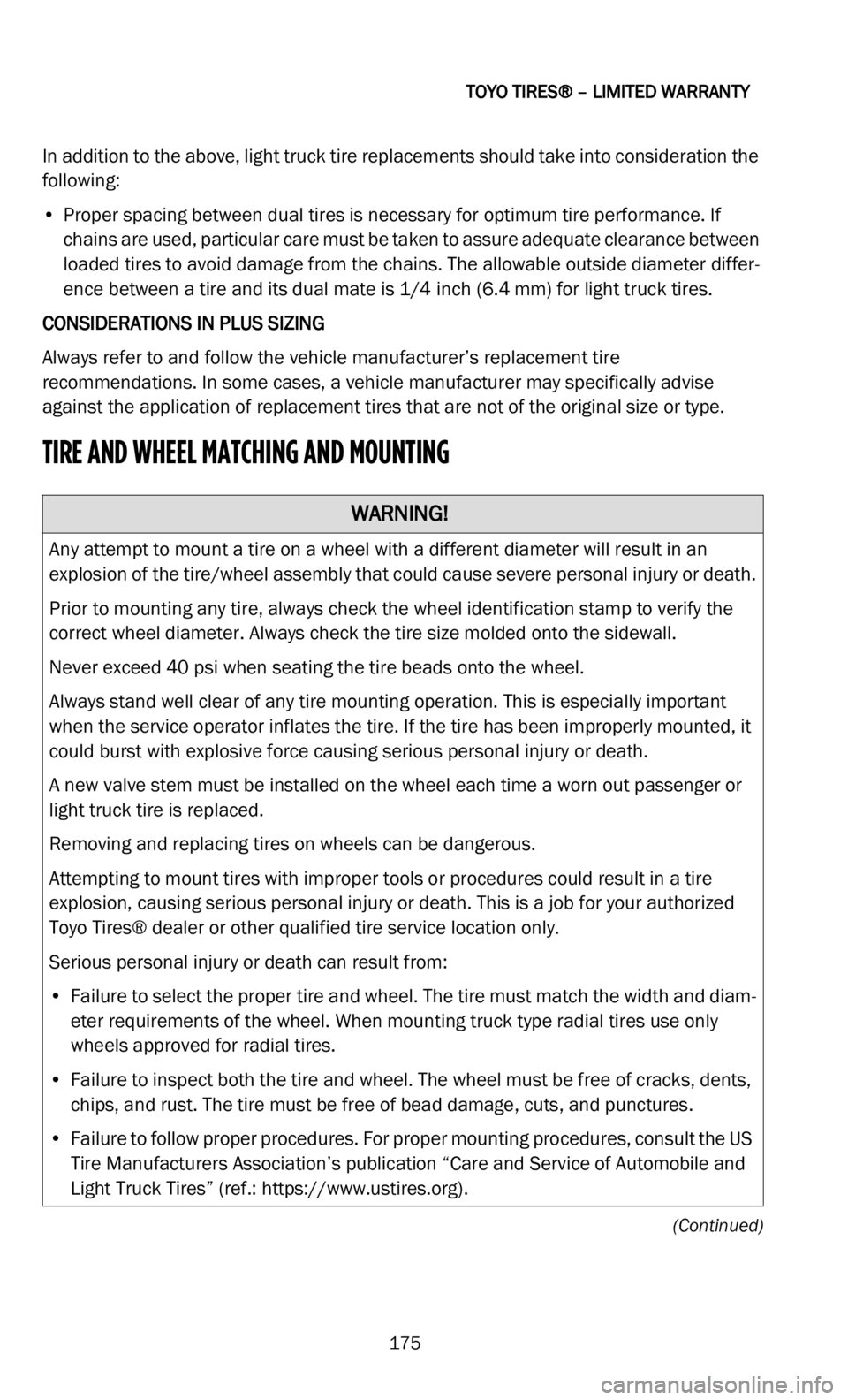
TOYO TIRES® – LIMITED WARRANTY
175
(Continued)
In addition to the above, light truck tire replacements should take into consideration the
following:
• P roper spacing between dual tires is necessary for optimum tire performance. If
c
hains are used, particular care must be taken to assure adequate clearance between
loaded tires to avoid damage from the chains. The allowable outside diameter differ -
ence between a tire and its dual mate is 1/4 inch (6.4 mm) for light truck tires.
CONSIDERATIONS IN PLUS SIZING
Always refer to and follow the vehicle manufacturer’s replacement tire
r e
commendations. In some cases, a vehicle manufacturer may specifically advise
against the application of replacement tires that are not of the original size or type.
TIRE AND WHEEL MATCHING AND MOUNTING
WARNING!
Any attempt to mount a tire on a wheel with a different diameter will result in an
explosion of the tire/wheel assembly that could cause severe personal injury or death.
Prior to mounting any tire, always check the wheel identification stamp to verify the
c o
rrect wheel diameter. Always check the tire size molded onto the sidewall.
Never exceed 40 psi when seating the tire beads onto the wheel.
Always stand well clear of any tire mounting operation. This is especially important
wh
en the service operator inflates the tire. If the tire has been improperly mounted, it
could burst with explosive force causing serious personal injury or death.
A new valve stem must be installed on the wheel each time a worn out passenger or
l i
ght truck tire is replaced.
Removing and replacing tires on wheels can be dangerous.
Attempting to mount tires with improper tools or procedures could result in a tire
ex
plosion, causing serious personal injury or death. This is a job for your authorized
Toyo Tires® dealer or other qualified tire service location only.
Serious personal injury or death can result from:
• F ailure to select the proper tire and wheel. The tire must match the width and diam -
e
ter requirements of the wheel. When mounting truck type radial tires use only
w h
eels approved for radial tires.
• F ailure to inspect both the tire and wheel. The wheel must be free of cracks, dents,
c
hips, and rust. The tire must be free of bead damage, cuts, and punctures.
• F ailure to follow proper procedures. For proper mounting procedures, consult the US
T
ire Manufacturers Association’s publication “Care and Service of Automobile and
Light Truck Tires” (ref.: https://www.ustires.org).
Page 177 of 200
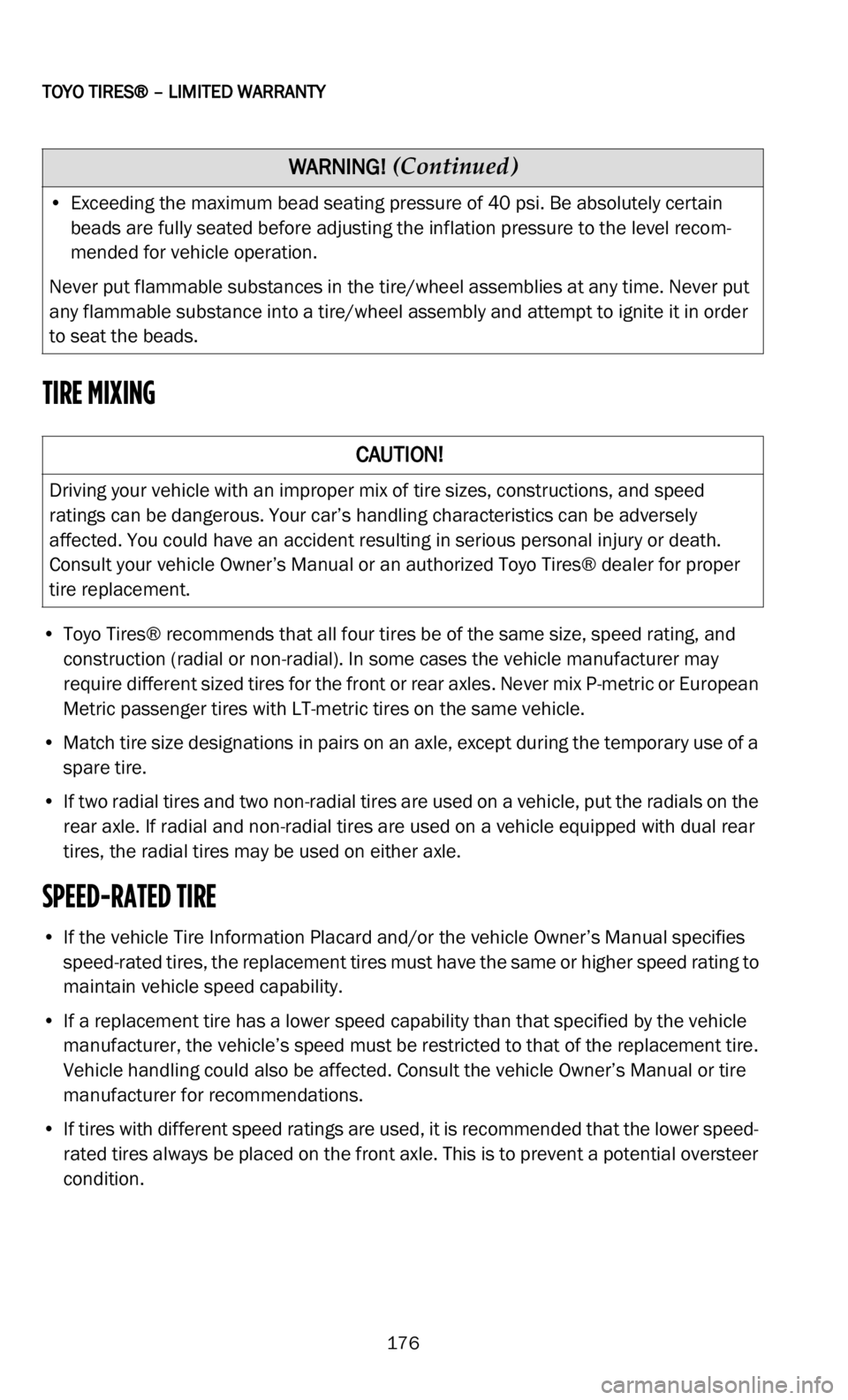
TOYO TIRES® – LIMITED WARRANTY
176
TIRE MIXING
• Toyo Tires® recommends that all four tires be of the same size, speed rating, and construction (radial or non-radial). In some cases the vehicle manufacturer may
require different sized tires for the front or rear axles. Never mix P-metric or European
Metric passenger tires with LT-metric tires on the same vehicle.
• M atch tire size designations in pairs on an axle, except during the temporary use of a
s
pare tire.
• I f two radial tires and two non-radial tires are used on a vehicle, put the radials on the
r
ear axle. If radial and non-radial tires are used on a vehicle equipped with dual rear
tires, the radial tires may be used on either axle.
SPEED-RATED TIRE
• If the vehicle Tire Information Placard and/or the vehicle Owner’s Manual specifies speed-rated tires, the replacement tires must have the same or higher speed rating to
maintain vehicle speed capability.
• I f a replacement tire has a lower speed capability than that specified by the vehicle
m
anufacturer, the vehicle’s speed must be restricted to that of the replacement tire.
Vehicle handling could also be affected. Consult the vehicle Owner’s Manual or tire
manufacturer for recommendations.
• I f tires with different speed ratings are used, it is recommended that the lower speed-
r
ated tires always be placed on the front axle. This is to prevent a potential oversteer
condition.
• E
xceeding the maximum bead seating pressure of 40 psi. Be absolutely certain
b
eads are fully seated before adjusting the inflation pressure to the level recom -
mended for vehicle operation.
Never put flammable substances in the tire/wheel assemblies at any time. Never put
a n
y flammable substance into a tire/wheel assembly and attempt to ignite it in order
to seat the beads.
CAUTION!
Driving your vehicle with an improper mix of tire sizes, constructions, and speed
ratings can be dangerous. Your car’s handling characteristics can be adversely
affected. You could have an accident resulting in serious personal injury or death.
Consult your vehicle Owner’s Manual or an authorized Toyo Tires® dealer for proper
tire replacement.
WARNING!
(Continued)
Page 178 of 200
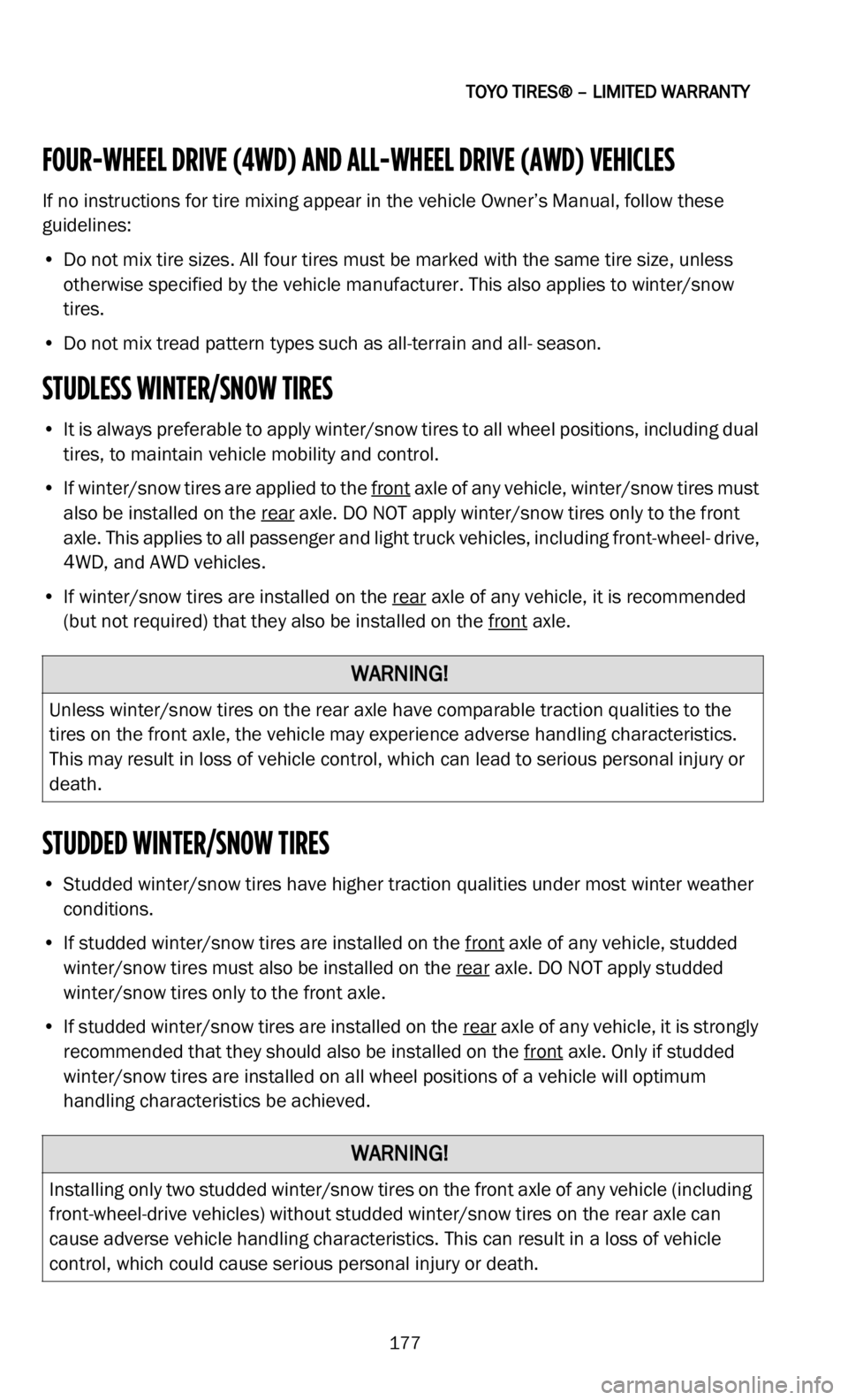
TOYO TIRES® – LIMITED WARRANTY
177
FOUR-WHEEL DRIVE (4WD) AND ALL-WHEEL DRIVE (AWD) VEHICLES
If no instructions for tire mixing appear in the vehicle Owner’s Manual, follow these
guidelines:
• D o not mix tire sizes. All four tires must be marked with the same tire size, unless
o
therwise specified by the vehicle manufacturer. This also applies to winter/snow
tires.
• D o not mix tread pattern types such as all-terrain and all- season.
STUDLESS WINTER/SNOW TIRES
• It is always preferable to apply winter/snow tires to all wheel positions, including dual
tires, to maintain vehicle mobility and control.
• I f winter/snow tires are applied to the f
ront axle of any vehicle, winter/snow tires must
also be installed on the
rear axle. DO NOT apply winter/snow tires only to the front
axle. This applies to all passenger and light truck vehicles, including front-wheel- drive,
4WD, and AWD vehicles.
• If winter/snow tires are installed on the rear axle of any vehicle, it is recommended
(but not required) that they also be installed on the
front axle.
STUDDED WINTER/SNOW TIRES
• Studded winter/snow tires have higher traction qualities under most winter weather conditions.
• I f studded winter/snow tires are installed on the f
ront axle of any vehicle, studded
winter/snow tires must also be installed on the
rear axle. DO NOT apply studded
winter/snow tires only to the front axle.
• If studded winter/snow tires are installed on the rear axle of any vehicle, it is strongly
recommended that they should also be installed on the
front axle. Only if studded
winter/snow tires are installed on all wheel positions of a vehicle will optimum
handling characteristics be achieved.
WARNING!
Unless winter/snow tires on the rear axle have comparable traction qualities to the
tires on the front axle, the vehicle may experience adverse handling characteristics.
This may result in loss of vehicle control, which can lead to serious personal injury or
death.
WARNING!
Installing only two studded winter/snow tires on the front axle of any vehicle (including
front-wheel-drive vehicles) without studded winter/snow tires on the rear axle can
cause adverse vehicle handling characteristics. This can result in a loss of vehicle
control, which could cause serious personal injury or death.
Page 179 of 200

TOYO TIRES® – LIMITED WARRANTY
178
REPLACING TWO TIRES
• When a pair of replacement tires is selected in the same size and construction as those on the vehicle, the two newer tires must be installed on the rear axle and must
be of equal or higher speed rating than the front tires. Generally, new tires with deeper
tread will provide better grip and evacuate water more effectively, which is important
as a driver approaches hydroplaning situations. Placing greater traction on the rear
axle on wet surfaces is necessary to prevent a possible oversteer condition and loss
of vehicle stability.
• W hen two new tires have been installed onto the rear axle positions, they are to be
k
ept on the rear but rotated from side to side. This is recommended after installing two
new tires to the rear position, or if you discover significant tread depth differences
between the front and rear positions during rotation intervals.
REPLACING ONE TIRE
• Replacing a single tire on a vehicle can have an adverse effect on suspension systems, gear ratios, transmission, and tire treadwear.
• I f single tire replacement is unavoidable, it is recommended that the single new tire
b
e paired with the tire that has the deepest tread and both be placed on the rear axle.
Placing greater traction on the rear axle on wet surfaces is necessary to prevent a
possible oversteer condition and loss of vehicle stability.
WHEEL ALIGNMENT AND BALANCING
• Proper wheel alignment and balance are very important considerations for safety and getting the maximum mileage from your tires. You need to check how your tires are
wearing at least once a month.
• Y our vehicle may be out of alignment if your tires are wearing unevenly, such as when
t
he inside shoulder of the tire is wearing faster than the rest of the tread. This condi -
tion not only shortens the life of your tires, it adversely affects the handling character -
istics of your vehicle, which could be dangerous. If your tires show irregular wear, have
y o
ur vehicle’s alignment checked immediately.
CAUTION!
In some cases, the vehicle manufacturer may specifically advise against replacing
fewer than all four tires. Always check and follow the recommendations in the vehicle
Owner’s Manual. For 4WD and AWD vehicles, even small differences in outside
diameter may cause drivetrain damage or mechanical malfunction.
Page 180 of 200
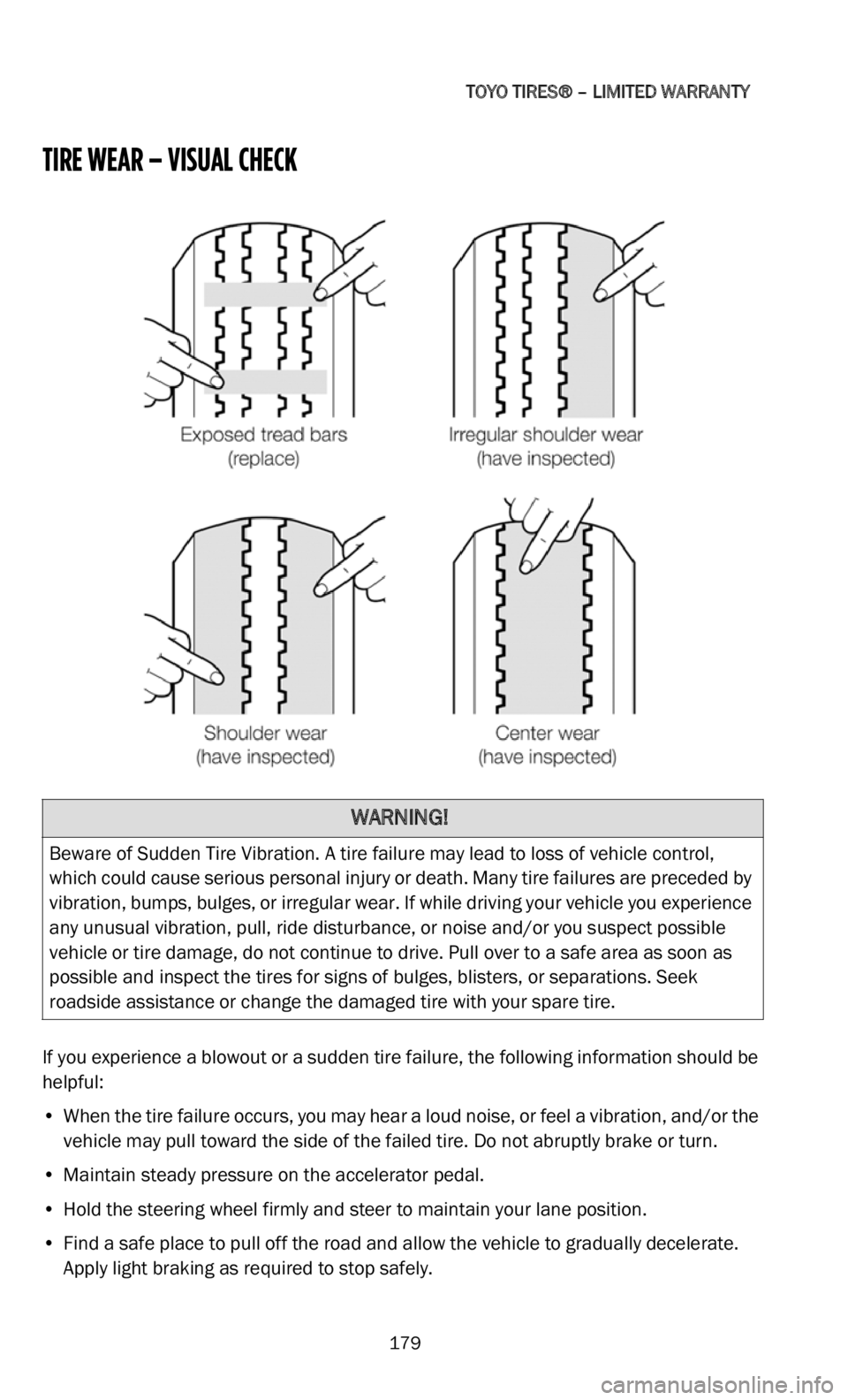
TOYO TIRES® – LIMITED WARRANTY
179
TIRE WEAR – VISUAL CHECK
If you experience a blowout or a sudden tire failure, the following information should be
helpful:
• W hen the tire failure occurs, you may hear a loud noise, or feel a vibration, and/or the
v
ehicle may pull toward the side of the failed tire. Do not abruptly brake or turn.
• M aintain steady pressure on the accelerator pedal.
•
Hold the steering wheel firmly and steer to maintain your lane position.
•
Find a safe place to pull off the road and allow the vehicle to gradually decelerate.
A
pply light braking as required to stop safely.
WARNING!
Beware of Sudden Tire Vibration. A tire failure may lead to loss of vehicle control,
which could cause serious personal injury or death. Many tire failures are preceded by
vibration, bumps, bulges, or irregular wear. If while driving your vehicle you experience
any unusual vibration, pull, ride disturbance, or noise and/or you suspect possible
vehicle or tire damage, do not continue to drive. Pull over to a safe area as soon as
possible and inspect the tires for signs of bulges, blisters, or separations. Seek
roadside assistance or change the damaged tire with your spare tire.